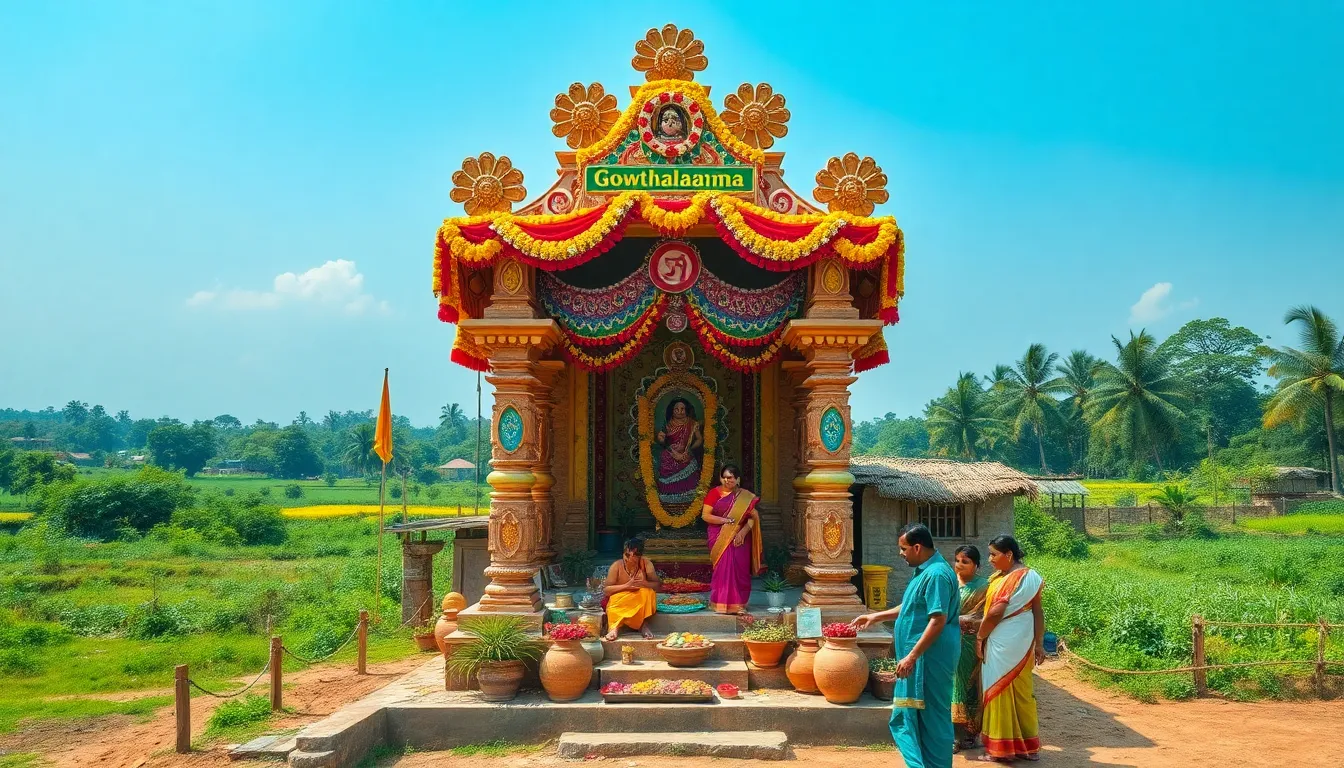Gowthalamma stands as one of the most revered folk deities in South India, particularly venerated in the rural regions of Andhra Pradesh. She’s not just any goddess—she’s the fierce protector of villages, the guardian against diseases, and the divine mother who answers prayers with remarkable efficiency (no customer service waiting times here!).
Her colorful temples dot the countryside, where devotees flock to offer vibrant sarees, bangles, and kumkum during festive celebrations. While mainstream deities might get all the Bollywood treatment, Gowthalamma keeps it real—maintaining her strong connection with farmers, laborers, and everyday folks who rely on her divine intervention for their daily challenges.
Table of Contents
ToggleThe Origin and History of Gowthalamma Worship
Gowthalamma worship traces back several centuries in South Indian folklore and religious traditions. Her cult developed organically among rural communities as a response to local needs for protection and divine intervention.
Ancient Roots in South Indian Culture
Gowthalamma’s origins connect deeply to the animistic and nature worship traditions prevalent in pre-Vedic South India. Archaeological evidence from the 8th century CE suggests early forms of folk goddess worship in coastal Andhra regions, where terracotta figurines resembling modern Gowthalamma iconography have been discovered. Rural communities initially venerated her as an agricultural deity who controlled rainfall and crop fertility. Many scholars believe Gowthalamma emerged from tribal traditions that honored female divine energies as manifestations of nature’s power. Her mythology intertwines with ancient Dravidian belief systems where village goddesses served as guardians against disease and natural calamities. Local oral histories indicate that Gowthalamma’s prominence grew during periods of epidemic outbreaks when villagers sought supernatural protection.
Evolution of Worship Practices Through Centuries
Gowthalamma worship transformed significantly between the 12th and 18th centuries as regional kingdoms rose and fell across South India. Temple architecture dedicated to her evolved from simple shrines under sacred trees to more elaborate structures with distinctive red and yellow paint. Medieval inscriptions mention annual festivals celebrating the goddess with animal sacrifices and nightlong rituals involving trance possession. Her worship absorbed elements from mainstream Hindu traditions during the Vijayanagara period, incorporating fire ceremonies and more formalized priestly roles. Colonial records from the 19th century document British officials’ observations of Gowthalamma festivals involving ecstatic dancing and community feasting. Despite modernization pressures, rural devotees have maintained core rituals like offering red flowers, turmeric, and specific food preparations that represent centuries-old traditions.
Religious Significance of Gowthalamma
Gowthalamma occupies a central position in the religious landscape of rural South India. Her spiritual importance extends beyond mere worship, embodying deep cultural values and addressing practical community needs that mainstream religious institutions sometimes overlook.
Role as a Village Guardian Deity
Gowthalamma functions primarily as a fierce protector of village boundaries, with her shrines strategically positioned at community entrances. Villagers credit her with safeguarding residents from epidemic diseases, natural calamities, and outside threats. During annual festivals, entire communities participate in special rituals designed to reinforce her protective mantle over the settlement. Farmers consistently seek her blessings before planting and harvesting crops, believing her divine intervention ensures agricultural prosperity. Her protective role extends to livestock, with special ceremonies conducted to secure animal health and fertility. Unlike distant temple deities, Gowthalamma maintains an accessible presence in daily village affairs, responding to immediate community concerns through oracles and village priests who serve as her intermediaries.
Relationship to Other Hindu Goddesses
Gowthalamma shares attributes with mainstream Hindu goddesses while maintaining distinct characteristics that reflect her folk origins. Religious scholars note her connection to Shakti traditions, identifying parallels with Kali and Durga in her fierce, protective aspects. Unlike temple goddesses requiring elaborate ritual access, Gowthalamma remains directly approachable by devotees from all social strata. Her iconography incorporates elements reminiscent of ancient mother goddesses, featuring agricultural implements and symbols of fertility. Throughout centuries of religious evolution, Gowthalamma absorbed characteristics from various goddess traditions while preserving her unique identity. In many communities, she occupies a complementary position to major deities, handling specific protective functions while mainstream gods address broader spiritual concerns. This syncretic relationship demonstrates the dynamic integration between folk traditions and orthodox Hinduism in South Indian religious practices.
Sacred Rituals and Festivals Associated with Gowthalamma
Gowthalamma worship encompasses a rich tapestry of rituals and festivals deeply embedded in South Indian folk traditions. These ceremonies reflect the intimate relationship between rural communities and their protective deity, blending ancient practices with contemporary devotion.
Annual Temple Celebrations
The Gowthalamma Jatara stands as the most significant festival dedicated to the goddess, typically held during the summer months in rural Andhra Pradesh. Villagers transform the temple grounds into vibrant celebration spaces adorned with colorful flags, mango leaves, and marigold garlands. The three-day festival begins with the ritual cleansing of the temple and idol, followed by a ceremonial procession where the goddess’s image travels through village streets on a decorated wooden chariot. Local musicians accompany the procession with traditional instruments like dhol drums and nadaswaram flutes. Many devotees fulfill vows during this period by walking on hot coals or performing hook-swinging rituals to demonstrate their devotion and gratitude for prayers answered throughout the year.
Traditional Offerings and Prayers
Devotees approach Gowthalamma with specific offerings tailored to her fierce yet protective nature. Red kumkum powder, turmeric paste, and vibrant saris represent the most common gifts presented at her altar. Animal sacrifices, particularly roosters and goats, remain part of rural worship traditions in remote villages despite modern restrictions. Farmers bring first harvest grains as thanksgiving offerings, placing them at the goddess’s feet before consuming them themselves. Special prayers called “naivedyam” involve the preparation of sweet rice mixed with jaggery and coconut, considered highly auspicious when offered during amavasya (new moon) nights. Temple priests recite mantras unique to Gowthalamma tradition, passed down through generations of specialized families entrusted with maintaining proper ritual protocols. Many devotees undertake fasting on Tuesdays and Fridays, believing these days hold special significance in connecting with the goddess’s divine energy.
Geographic Distribution of Gowthalamma Temples
Gowthalamma temples dot the landscape of South India, with concentrations varying across different regions. These sacred spaces range from modest village shrines to more elaborate structures in semi-urban areas, each reflecting local cultural influences and worship traditions.
Major Worship Centers in Andhra Pradesh
The coastal districts of Andhra Pradesh host the highest concentration of Gowthalamma temples, particularly in East Godavari, Visakhapatnam, and Srikakulam regions. Tuni in East Godavari district features one of the most prominent shrines, attracting thousands of devotees during annual festivals. Anakapalle’s historic Gowthalamma temple serves as a regional pilgrimage center with distinctive architectural elements blending folk and classical styles. Rural communities throughout Krishna and Guntur districts maintain numerous village temples where she’s worshipped as the primary protective deity. Smaller shrines exist in virtually every village across the Rayalaseema region, establishing a widespread network of worship centers throughout the state.
Regional Variations in Worship Practices
Temple architecture reflects notable regional differences across Gowthalamma’s worship geography. Coastal temples typically feature colorful facades with detailed folk art depicting the goddess in various forms, while interior regions favor simpler structures with symbolic stone representations. Ritual practices vary significantly – eastern districts incorporate elaborate animal sacrifices during festivals, central regions emphasize vegetarian offerings and fire ceremonies, and southern temples blend her worship with mainstream goddess traditions. Telangana’s Gowthalamma shrines display unique ceremonial traditions including specialized drumming patterns during invocations. Seasonal worship timing also differs regionally, with coastal areas celebrating major festivals during harvest months and inland regions scheduling ceremonies before monsoon season begins.
Cultural Impact of Gowthalamma Worship
Gowthalamma worship has profoundly shaped the cultural landscape of rural South India, particularly in Andhra Pradesh. Her influence extends beyond religious practices, permeating various aspects of daily life including artistic expressions, storytelling traditions, and community values that continue to resonate in contemporary society.
Influence on Local Art and Literature
Gowthalamma’s powerful imagery inspires diverse artistic expressions throughout rural Andhra Pradesh. Folk paintings called “patachitras” frequently depict her fierce form, using vibrant reds and yellows to symbolize her protective energy. Local sculptors craft distinctive terracotta figurines of the goddess, characterized by their expressive features and dynamic postures. Traditional ballads known as “burrakatha” preserve ancient narratives of her miraculous interventions, with traveling performers sharing these stories during village festivals. Poets have composed numerous devotional songs or “janapada geethalu” in her honor, featuring rhythmic patterns unique to regional folk traditions. These artistic representations serve as cultural repositories, transmitting beliefs about Gowthalamma’s divine protection across generations.
Contemporary Relevance in Modern Society
Gowthalamma worship remains remarkably resilient despite rapid urbanization and technological changes in South India. Young professionals from rural backgrounds continue visiting her shrines during critical life events, blending traditional devotion with modern lifestyles. Social media platforms now feature dedicated groups where devotees share festival photographs, ritual information, and personal testimonials about the goddess’s intervention. Urban migrants maintain connections to their ancestral villages through participation in annual Gowthalamma celebrations. Several non-governmental organizations have documented her worship practices as part of cultural heritage preservation efforts. The goddess’s traditional ecological values regarding protection of water sources and agricultural land resonate with contemporary environmental concerns. Her continued popularity demonstrates how folk traditions adapt and find new relevance rather than disappearing in the face of modernization.
Conclusion
Gowthalamma stands as a remarkable testament to the enduring power of folk religion in South India. Her worship bridges ancient traditions and contemporary needs while maintaining its distinctive character despite centuries of cultural evolution.
The goddess’s continuing relevance speaks to her deep significance in the spiritual landscape of rural communities. As both fierce protector and accessible deity she fulfills unique roles that mainstream Hindu traditions often cannot.
Across Andhra Pradesh and beyond her vibrant festivals and sacred rituals demonstrate how indigenous beliefs adapt and thrive. Gowthalamma’s worship represents not just religious practice but a living cultural heritage that connects generations through shared devotion to their beloved guardian goddess.



